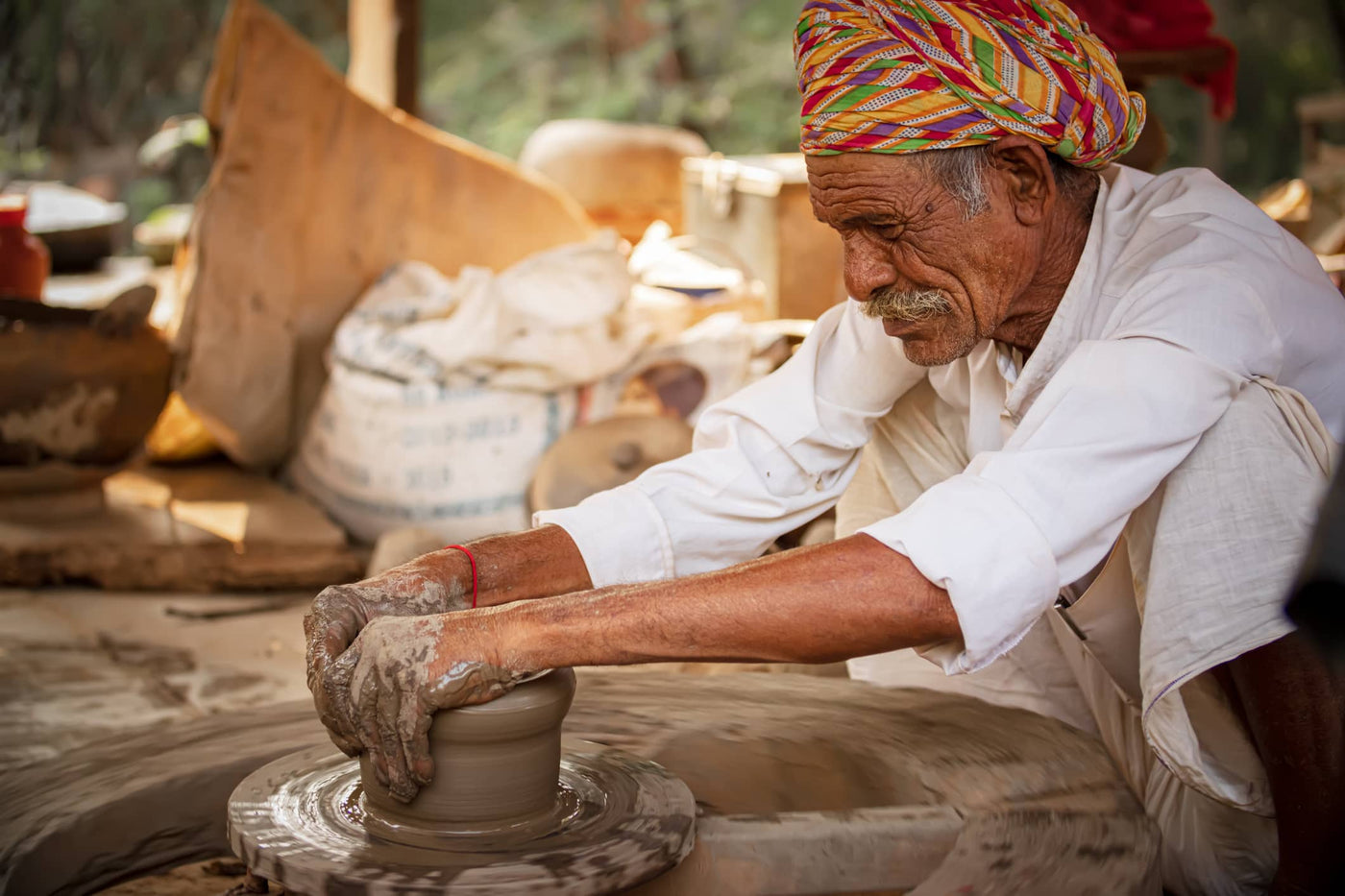News

14 Pottery Facts You Didn’t Know
Pottery has been a fundamental part of human history for thousands of years, serving both functional and artistic purposes.
From ancient civilizations to modern art galleries, pottery has maintained its place as a versatile and enduring art form. In this blog post, we will delve into 14 pottery facts that you may not have known, shedding light on the fascinating world of ceramics and clay.
1. The Invention of Pottery Impacted How Humans Live
Tracing back to around 10,000 BCE, the inception of pottery marks a pivotal moment in Neolithic advancements.
Initially, these clay creations were fashioned into basic containers, their primary role to store essential supplies like food and water. This innovation underscored the shift towards more sedentary human settlements.
The technique involved molding clay by hand and then subjecting it to heat in primitive kilns, a process that catalyzed the transformation of simple clay forms into durable pottery. This early venture into pottery laid the groundwork for the elaborate and sophisticated ceramic practices that would eventually span cultures and epochs around the globe.
2. Pottery Had Many Functions in Ancient Societies
Pottery in ancient societies extended far beyond mere utility. It played a crucial role in spiritual rituals, acted as grave goods, and even functioned as a medium of exchange.
The ornate motifs and patterns adorning these artifacts offer a window into the spiritual life, traditions, and societal hierarchies of bygone civilizations, illustrating how integral pottery was to cultural expression and daily life.
Through these remnants, we gain profound insights into the complexities of ancient human societies, highlighting pottery's significance beyond its physical form.
3. Pottery Techniques are Dynamic and Complex
Pottery techniques have seen remarkable transformations, evolving from simple hand-forming methods to complex wheel-throwing and slip-casting processes.
Innovations in glazing and firing have expanded the possibilities for functional and decorative ceramics, allowing for greater durability and a wider range of textures and colors.
Experimentation with different types of clay and kiln technologies has further diversified the craft, enabling artists to explore new forms and expressions. These advancements highlight the dynamic nature of pottery, illustrating its adaptability and the continuous quest for artistic and technical excellence in the field.
4. Glazes Enabled a World of Colorful Art
Glazes can infuse ceramic pieces with vibrancy and depth. These transformative substances, concocted from minerals and oxides, meld with the surface of clay under the intense heat of the kiln, resulting in a mesmerizing spectrum of finishes. From the deepest blues to the most subtle of ivories, glazes can create a real point of difference for each piece.
5. Porcelain Influenced Trade Throughout The World
China's invention of porcelain during the Tang dynasty marked a significant milestone in ceramic history.
Esteemed for its strength and ethereal beauty, porcelain captivated markets far beyond its homeland. This groundbreaking development not only showcased China's advanced ceramic techniques but also set a new standard for quality and aesthetics in pottery.
The allure of porcelain spurred a global demand that influenced trade routes and inspired countless artisans, emphasizing its pivotal role in the artistic and economic landscapes of the time.
Further Reading: A Guide to China Paint Materials, Techniques and Firing.

6. Pottery Has Created Famous Artists
The annals of pottery history are graced with influential figures whose innovative works have transcended time. Among them, the ancient Greek potter Exekias is celebrated for his detailed black-figure technique, while the British Bernard Leach is revered for merging Eastern and Western pottery traditions.
American Beatrice Wood, known as the "Mama of Dada," infused her ceramics with a whimsical, avant-garde spirit. These trailblazers, along with countless others, have indelibly shaped the ceramic arts, challenging and expanding the boundaries of what is possible with clay.
Further Reading: 8 Ceramic Artists Known for Their Signature Style.
7. Pottery is Still Used in Modern Art and Design
Today, pottery is experiencing a renaissance in the realms of modern art and design, with creatives integrating ceramic elements into groundbreaking works. This movement spans from sleek, minimalist installations to functional art pieces that challenge traditional perceptions of ceramics.
Contemporary artists are redefining pottery, proving its versatility and bringing it to the forefront of both aesthetic innovation and everyday utility. This resurgence is a testament to pottery's adaptability, bridging centuries-old techniques with the cutting-edge visions of today's designers.
8. Pottery Has Therapeutic Benefits
Engaging with pottery provides a unique form of stress relief and mental health support. The act of shaping clay offers an immersive, hands-on experience that can aid in reducing anxiety and enhancing concentration. As individuals lose themselves in the art of pottery, they often find a sense of peace and accomplishment, making it a powerful tool for emotional well-being.
9. Pottery Around the World: Diverse Styles and Techniques
The art of pottery manifests uniquely across the globe, celebrating the diversity of human expression. Japanese raku ware offers a distinctively organic aesthetic, characterized by its spontaneity and surprise in texture and color. African pottery, rich in symbolism, utilizes handbuilding techniques passed down through generations, reflecting deep cultural narratives.
In Italy, the Renaissance sparked the refined majolica technique, producing vibrant, intricately painted ceramics.
10. Pottery Is Becoming Greener
Pottery's embrace of earth's elements comes with ecological considerations, particularly during the firing stage. The energy-intensive nature of traditional kilns contributes to a significant carbon footprint, emitting CO2 and other pollutants.
Awareness of these impacts is fostering a shift towards greener methods, including the adoption of electric kilns powered by renewable energy sources and the development of environmentally benign glazes.
11. Handmade Pottery Is Making a Resurgence
Amidst an age saturated with mass production, there's been a discernible shift back towards the allure of handmade pottery. This reflects a yearning for authentic and skillfully crafted pieces with their unique imperfections and tactile qualities.

12. Firing Clay Has Turned Into a Precise Science
The transformation of clay into a solid ceramic during firing is a fascinating chemical process. At temperatures ranging from 1,000 to 2,400 degrees Fahrenheit, the silica within clay particles starts to vitrify, effectively turning into a glass-like substance that binds particles closer together, enhancing durability.
This metamorphosis also affects the clay's porosity and color, determined by the specific heat level and the clay's mineral composition. Mastery of firing techniques allows potters to precisely dictate the final appearance and functionality of their creations.
13. History Has Produced Some Iconic Pottery Pieces
Throughout centuries, certain pottery works have stood out, becoming symbols of their time and markers of artistic achievement. The Grecian urns, celebrated for their storytelling through detailed imagery, the exquisite Ming vases of China, known for their complex glazes and intricate designs, and the Native American Anasazi pottery, which reflects a deep connection to the land and its people, are prime examples.
14. Pottery Is Ever Evolving
In the forward-looking sphere of ceramics, artisans are merging age-old traditions with cutting-edge innovations. The adoption of 3D printing technology is revolutionizing the way pottery is conceived and created, allowing for unprecedented complexity and precision in design.
Additionally, the quest for sustainability is driving the development of eco-friendly clays and glazes, minimizing the environmental footprint of pottery. These trends underscore a dynamic fusion of respect for tradition and a drive for ecological and technological advancement, promising a vibrant and sustainable future for pottery.
Want to know more about pottery and the tools to create it? Please contact Soul Ceramics today - we can help you realize your pottery dream.- Lea Mendoza
15 Impressive Blown Glass Masterpieces
It takes a lot of practice to master the skill of glass blowing. Perhaps, tiny pieces will be a good starting point.
"Every Artist was first an amateur" - Ralph Waldo Emerson
We hope y'all enjoyed our featured artist and their masterpiece.
- Lea Mendoza
14 Beautifully Designed Metal Clay Jewelry Pieces
In order to come up with a good result, one must have a proper training, the right type of metal clay and materials to use.
It is worth investing in purchasing a kiln for metal clay work as this will make the work load so much easier and faster.
Without a doubt, jewelry making is not just an accessory that adds beauty to someone but like other art works, it's a form of self expression and artistry.
- Lea Mendoza
9 Fabulous ways to decorate your ceramics
Whatever style you want and decoration you choose - it will surely bring joy and happiness to someone.
Truly artistic and lovely decorations!
- Lea Mendoza
- Tags: ceramic ceramicdecoration educational entertaining inspiration list

18 Animal Ceramic That Will Melt Your Heart
“Until one has loved an animal, a part of one’s soul remains unawakened.” –Anatole France
- Lea Mendoza
- Tags: animalceramic ceramic entertaining inspiration
6 Perfectly Crafted Handmade Damascus Blades
We hope you enjoyed our featured artist and their masterpiece.
See you on our next post!😉
- Lea Mendoza
- Tags: inspiration Knife Making list





















